Blueberry Wine Recipe – Full-Bodied and Beginner Friendly
This blueberry wine recipe is the perfect choice for the beginning winemaker, it also produces a fantastic wine that is full of the flavour of blueberries, what could be better than that?
When you look at the blueberry it does almost look like a small grape, that is not to say it blueberries have the same qualities as grapes do for making wine they need a little help from you the winemaker.
What blueberries do have though is lots of flavour and colour. This wine recipe makes a rich dark wine similar in colour to a Bordeaux or Syrah.
Table of Contents
Gathering Your Winemaking Ingredients
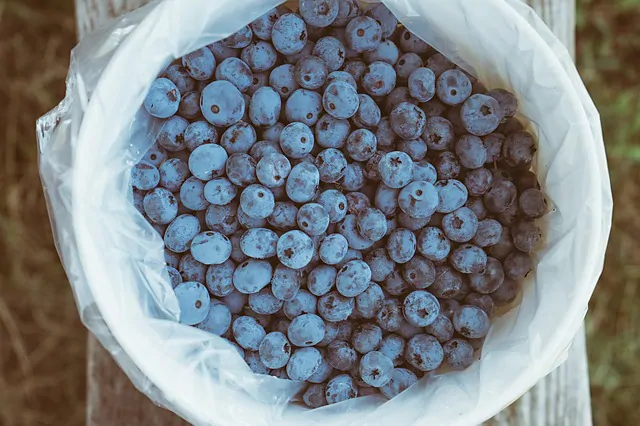
This deep dark colour comes from the skins of the blueberries just as would come from the skins of grape wine.
If you cut a blueberry in half you will notice the inside of the berry has a green hue. The result of this blueberry wine recipe, however, is a deep, dark violet.
The colour is extracted from the skins as they sit in the fermenter macerating. Yeast and a slowly increasing alcohol content both help this process along as well as drawing the flavour and sugar from the fruit.
A Simple But Delicious Blueberry Wine
The reason this wine recipe is such a good wine to make for the beginner is the ease of the process and the resulting wine is delicious.
Many fruit wine recipes require lots of small tweaks and refining to produce a decent result whereas blueberry wine produces a good wine even if you don’t get everything just right.
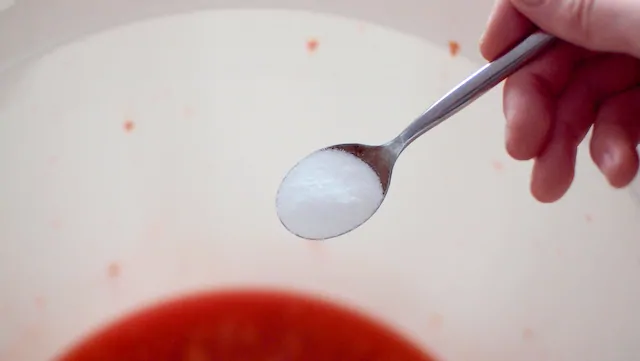
There are a few additives that you’ll want in this blueberry wine, these are just the usual suspects of any fruit wine.
Acid blend and tannin are required for the vast majority of fruit wines and this blueberry wine is no exception. You should have these kinds of additives, along with pectic enzymes which will extract more from the berries and prevent wine haze and yeast nutrients to hand for any fruit wine you intend to make.
The blueberries you use, whether they are frozen or fresh, are up to you. As long as the fruit is good quality and ripe you should be in for decent blueberry wine.
Using Frozen Blueberries
Frozen fruit tends to be picked when it’s riper than fresh fruit from the supermarket in this case picking the frozen fruit will result in a better wine. Freezing the fruit will also break down the cells of the fruit releasing the juices and flavour better than just mashing the fruit.
I have used frozen blueberries for this recipe. You can get them year-round and they are much cheaper than fresh berries.
If you can get hold of wild blueberries you can, of course, use these, picked at their ripest and being able to choose the highest quality blueberries will make a superior wine.
There aren’t many places in the UK where blueberries grow in the wild, they like heathland with acidic soil and are often called bilberries or blueberries. If you do intend to pick berries yourself make sure you have properly identified them as blueberries as they can be easily confused with other varieties of plant.
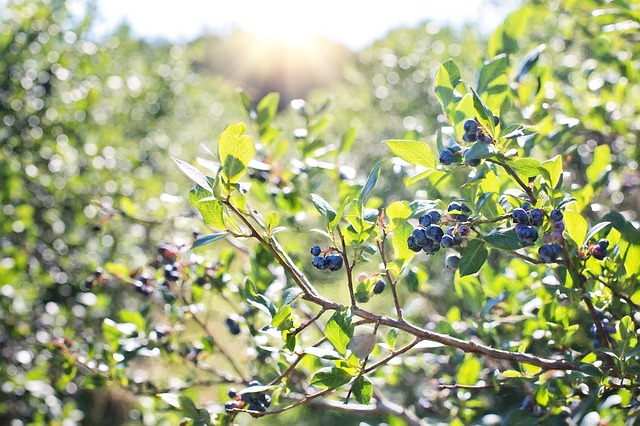
You can grow blueberries in pots in the garden so this might be worth considering if you intend to make a batch of blueberry wine every year, it’s a good recipe so definitely worth considering.
How To Make Blueberry Wine
To make this blueberry wine recipe you’ll need the following piece of equipment:
- Fermenting Bucket
- Nylon Straining Bag
- 1 Gallon Demijohn
- Bung & Airlock
- Potato Masher
- Hydrometer
- Syphon
- Bottles, Corks and Corker
The Blueberry Wine Recipe Ingredients – Makes 4.5 litres / 1 gallon around 12% ABV
1.4kg Blueberries fresh or frozen (clean and prepared)
1kg Sugar
4.2 litres Water
2 tsp Mixed Acid
1/8 tsp Tannin
1 tsp Yeast Nutrient
1/2 tsp Pectic Enzyme
1 Campden Tablet
1 sachet Wine Yeast (My recommendations – Vintners Reserve R56 / Lalvin 71B / Lalvin EC1118)
Blueberry Wine Recipe Method
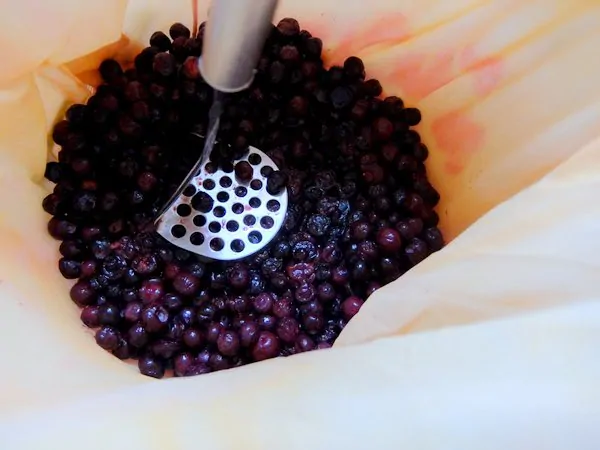
- Dissolve the sugar and half the water together in a pan by bringing it to a boil. Ensure all of the sugar is fully dissolved and then turn off the heat.
- Whilst heating the sugar and water put the blueberries in a straining bag in the bottom of the fermenting bucket. Use the potato masher to squash the blueberries and break them up. They don’t need to be pureed but make sure all the blueberries are squashed and the juices released.
- Pour the boiled sugar and water solution over the blueberries and mix well with the fruit. Add the second half of the water which will help to cool down the must.
- Add the acid, the wine nutrient, and the tannin and mix thoroughly, leave for a few hours to cool further and then add a crushed Campden tablet and for at least 12 hours.
- After 12 hours add the pectic enzyme and leave the must for 24 hours. After this, you can test with a hydrometer if you wish for the starting gravity.
- After the 24 hours add the yeast to begin fermentation. Allow fermentation to go on for a week and stir once every one or two days, this helps extract as much flavour from the fruit as possible which will have the tendency to float.
- After a week lift out the straining bag with the pulp and allow to drain as much as possible, avoid squeezing the bag.
Take a hydrometer reading, if the wine is below 1.010 specific gravity rack the wine into a sanitised demijohn. If not leave for a further few days and check the gravity again. Once racked attach a bung and airlock and leave. - Wait for at least 2 months or more and the wine can then be racked off the sediment. You can wait for the blueberry wine to completely clear before racking to a new vessel. After this either let it age further for a few months or bottle it. If you wish to back-sweeten the wine stabilise and follow this advice here.
This blueberry wine recipe will make a wine of around 12% ABV. It is best squirrelled away for a while to condition and mature. It keeps well for a couple of years, try and keep some around to sample and you will begin to understand how the wine changes with time.

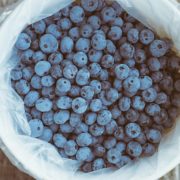


Over the next week or two I am reading the book you recommended by John Peragine, “Making your own Wine at home”; and I plan to try this blueberry wine first. I did wonder if capped beer bottles would be suitable for storage. I thought that 12 oz would be a nice size for a dinner for two. But I’ve never seen wine in a capped bottle before… whence the question.
Thanks for the article and recipe!
I have never bottled wine with capped bottles before but I see no reason that it wouldn’t work. I would probably advise to keep the bottles upright so the wine isn’t in contact with the caps for long periods. As long as you have an airtight seal on the bottle then it should be fine.
Glad you enjoyed the recipe and hope the wine turns out well!
HI. When fermenting in the bucket, do you fit the lid tight with an airlock or loosely with the straining bag overhanging the top of the bucket?
Thanks
Secure the straining bag inside the bucket and then tightly close the lid.
Just finishing up a 7 day fermentation bucket of Papaya preparing it for second fermentation. Each day after stirring, I press the lid down tight on the bucket and burp the lid by pressing in the middle of lid. The airlock does the release work. Tight lid keeps the flavor in.
Craig and Neil, my own will be ready to bottle in a few weeks… can’t wait! I would just say that during that week you will be opening the bucket and stirring things. So you can’t keep extra oxygen out during this time. I did as you described: I left the bag draped over the side of the bucket with the lid totally over it. An airlock, even empty, prevents critters coming thru the hole.
I’m not sure how the bag could be secured inside without the bag being immersed in the must… which would get very messy.
Thoughts Neil??
I have a 5 gallon fermenting bucket and a 5 gallon cariboy. Calculating the 1.4kg to pounds, it looks like I will need 19.3 pounds of blueberries. Is that about right or maybe i should use more? I picked fresh unspray d blueberries that I plan to feeexe for a few days before starting the wine. I guess I need to multiply everything else by 5 or would that be too much of any one ingredient like the tannin or citric acid?
Any thoughts on trying to make it organically without the campden tablets or would that be too risky?
Thanks for your help!
I would say between 16 – 20 lbs to be the right ballpark. The rest of the ingredients can be scaled up 5 times as you say. You do not have to use Campden tablets but there is always a risk of bacterial contamination which the Campden tablet would combat. If you use boiling water this has a sanitising benefit killing some possible spoilage microbes but you would have to decide this for yourself, it is a lot of fruit so I would be cautious.
It is a precaution against the wine turning to vinegar however, I used the Camden tablet once and didn’t like the taste. Since that time 5 years ago I go completely organic. My wine is fine without all those extra ingredients. 5 gallon bucket, Water, sugar, yeast and fruit. Tastes great! Guess i’m lucky.
Hi there, I usually make plum wine from a tree in the garden by cutting the plums up into the fermentation bin and pouring the boiling water on top of them.
I’m interested to know your view on what would happen if I just put the mashed blueberries into the bin with no cloth to hold them in. Would it just mean I’d have to rack more frequently to remove sediment?
Hi Brad, the only problem with doing this would be separating the blueberry pulp from the wine. I use a straining bag to make it easy to just pull everything out. It will likely take more rackings and will take longer to clear because of the blueberry particles but it shouldn’t impact the finished wine at all.
Excellent. Many thanks for the reply.
Why would you not want to squeeze/strain as much juice as possible out of the blueberries, when removing the bag from the must?
Thanks!
Squeezing the bag is not a serious problem. It will take the wine longer to clear though. I find the amount of liquid extracted is not worth the added time to clear.
If you are making grape wine where all the juice comes from the grapes then of course pressing is essential.
Hi Neil,
I love the website/recipe ideas. I’m just starting out so please forgive my ignorance! I see most of the recipes make 6 bottles. If I want to make 24 bottles, I understand I would multiply fruit, sugar and water by 4. My confusion comes with the additives, 2 tsp Citric Acid,1/8 tsp Tannin,1 tsp Yeast Nutrient,1/2 tsp Pectic Enzyme,1 Campden Tablet,1 sachet Wine Yeast. What quantities of these should I use for 24 bottles? It would be a great help, since I can apply to all the recipes.
Kind regards, Darren.
The scaling of recipes is all linear so you just need to multiply all the ingredients and the additives for the amount you want to make. Yeast sachets usually state on the package how much wine they are suitable for so you just need to check that. You may only need one sachet of yeast.
Hope this helps!
Is there a way to print out just the recipes on the site? I like to keep printed copies but don’t want to print the whole page.
Currently, there is no easy way to do this, sorry about this. I will look at implementing this on all the recipes soon.
I have a 1.5 gallon crock that has a lid, that I would like to use. Do you have any suggestions for using a crock container?
If you intend to use a crock you will want to make sure it is airtight and has an airlock of some sort otherwise the wine will oxidise quite quickly.
Very new to home brewing, this is only my second attempt, first with real fruit. I interpreted the “after 7 days” as meaning after adding the yeast, but wondering if it was since the start of the whole process? As such I have let it ferment for 7 days before taking my hydrometer reading and it’s already under 1.000 (just). I have transferred to a demijohn now but wondering if I’ve left it too long. What problems could this cause?
Yes it was intended to indicate 7 days after adding the yeast. No need to worry.
We have tired making some grape wines but never with frozen fruit . Want to try making this blueberry wine . What are your thoughts using raw organic honey instead of sugar?
Raw organic honey is a great choice I would go for it.
Is it normal if after a week, my gravity is way off from the 1.010 yours was at? Mine is at 1.060. Should I just leave it and keep checking, or add more sugar? Thanks!
It sounds like it is still fermenting, leave it a little longer and then if there is no further movement then you may need to repitch more yeast. Hope it goes OK.
If using frozen blueberries do you allow them to defrost first
Yes allow them to come to room temperature
I enjoy your question and reply part very much. I also, just started in making wine. My question is, if I am making one gallon at a time, is my 5 gallon fermenting bucket too large? I am I to have the least amount of air at this point too?
It is not ideal but I would still continue. When you can switch over to a smaller fermenter.
The more headspace the higher the chance of oxidation which isn’t great but you can still produce good results.
Oh, one more question. Does your recipe for adding yeast, do you make it according to back of packet? First wine I tried just had me dump it into juice.
For optimal results follow the instructions on the packet but it won’t be detrimental if you just sprinkle onto the surface, especially for a 1 gallon batch.
I made this last summer. It’s amazing. Made a 6 gallon batch. My question is a calorie count. Any chance you know the calories in a 5 oz glass ?
The calories per 250ml will be around 230cal. Calories are calculated by the alcohol content of the wine.
Hi, what happened if you added to much tannin? I just started a batch of blueberries wine the recipe says 1/8 tsp of tannin but I couldn’t find my tsp so I just use the 1/4 tsp.so just wondering if my batch gonna out ok or what should i do?
Tannin will add an astringent or bitter character if too much is added. You haven’t added too much extra so I think the wine will be fine.
My blueberry wine fermentation slows down in significantly after 4 days and now (5 days) it’s basically stopped. The initial hydrometer reading was 1.094 and after 4 days it was 0.99. Is there anything wrong?
Sounds completely normal. Fermentation will still be happening and byproducts of fermentation will be removed by the yeast so it is important to give the wine more time.
I am thinking of making Acai Berry wine. I have a massive bush of them every year that go to waste. Can you think of any reason I couldn’t substitute the blueberries for Acai in this recipe? Because of their scarcity no-one seems to have tried making it.
It sounds great to me. I have no experience with making wine with Acai berries so it sounds like you will be the pioneer. You can always adjust the acid and tannin content after fermentation if needed rather than adding these at the start of fermentation. You may find the wine if quite acidic depending on the acid content of the berries.
Hey. Great article. Was wondering, what do you think about using blueberry juice concentrate? I found a source that offers pure juice concentrate with no additives. It looks to be deep purple in color, so I would think the skins already imparted the color into the concentrate.
It sounds like a great idea. Just make sure there are no preservatives in the juice as these may affect the yeast and feremntation. I would be interested to see how it goes.
Hi in following your recipe do i need to multiply the number of Campden Tablets for 3 gal?
They use bottle cap s on wine bottles here in Italy. Not common but it is done. We live in the far the Northeast province of Frulia Venezia Guilia. Prosecco country…